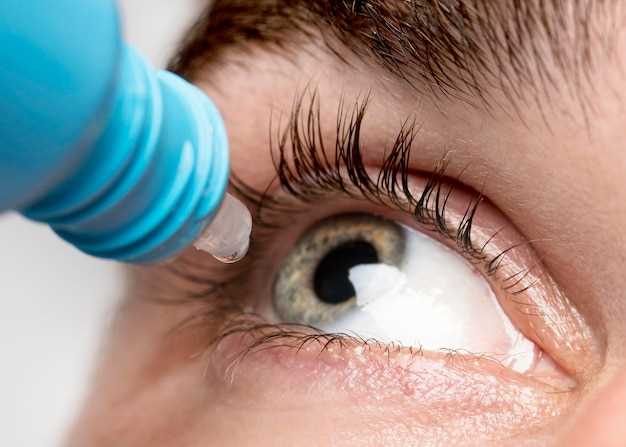
Are you considering taking Lisinopril for your blood pressure? While it is an effective medication, it’s important to be aware of the potential side effects. One area of concern is how Lisinopril can impact your eyes.
Blurry vision
Some users have reported experiencing blurred vision as a side effect of taking Lisinopril. While this is relatively rare, it’s worth noting that any changes in your vision should be taken seriously. If you notice any blurriness or difficulty seeing clearly, it’s important to consult with your doctor.
Dry eyes
Another potential side effect is dry eyes. This can cause discomfort and irritation, making it difficult to perform daily activities. If you notice a persistent dryness or a gritty feeling in your eyes while taking Lisinopril, be sure to talk to your healthcare provider.
Eye swelling
In rare cases, Lisinopril can cause swelling in the eyes or face. This can be a sign of an allergic reaction or a more serious side effect. If you experience any swelling or other unusual symptoms, seek medical attention immediately.
While not everyone will experience these side effects, it’s important to be aware of the potential risks before starting Lisinopril. Make sure to discuss any concerns or questions with your healthcare provider to determine the best course of treatment for your blood pressure. Your eyesight is precious – take care of it!
Understanding Lisinopril Side Effects on Eyes
Lisinopril is a medication commonly used to treat high blood pressure and heart failure. While it is generally safe and effective, some individuals may experience side effects, particularly related to their eyes.
When taken orally, lisinopril works to relax blood vessels and improve blood flow throughout the body. By doing so, it helps to reduce blood pressure and prevent certain heart conditions. However, this medication can sometimes cause side effects, including those that affect the eyes.
How Does Lisinopril Affect the Eyes?

Lisinopril is known to cause changes in the blood vessels, which can affect the delicate blood vessels in the eyes. These changes can lead to various eye-related side effects, such as:
- Blurred vision
- Dry eyes
- Eye pain or discomfort
- Visual disturbances
In some cases, these side effects may be temporary and resolve on their own after the body adjusts to the medication. However, it is important to monitor any changes in vision or eye discomfort and report them to your healthcare provider.
Reducing the Risk of Side Effects
To reduce the risk of experiencing lisinopril-related side effects on the eyes, it is essential to follow the prescribed dosage and usage instructions provided by your healthcare provider. Additionally, regular eye exams can help detect any potential issues early on, allowing proactive intervention and management.
If you experience any changes in vision or eye-related symptoms while taking lisinopril, it is crucial to notify your healthcare provider promptly. They can assess the situation and determine the best course of action, which may include adjusting the medication or considering alternative treatment options.
Remember, each individual may react differently to medication, and it is essential to prioritize your eye health and overall well-being. By working closely with your healthcare provider and staying vigilant about any changes, it is possible to minimize the potential side effects of lisinopril on the eyes.
Potential Side Effects on Eyes
Lisinopril is an angiotensin converting enzyme (ACE) inhibitor used primarily for the treatment of high blood pressure and congestive heart failure. While it is generally well-tolerated, there are potential side effects that may occur, particularly when it comes to the eyes.
One of the potential side effects of Lisinopril on the eyes is blurred vision. This occurs as a result of changes in the blood vessels in the eye, which can cause fluid buildup and affect the ability of the eye to focus properly. If you experience blurred vision while taking Lisinopril, it is important to notify your healthcare provider.
In rare cases, Lisinopril can also lead to a condition known as posterior reversible encephalopathy syndrome (PRES). PRES is characterized by swelling in the brain, and it can affect the eyes by causing visual disturbances. If you notice any changes in your vision, such as seeing flashes of light or experiencing tunnel vision, it is crucial to seek medical attention immediately.
Another potential side effect on the eyes is dry eyes. Lisinopril can disrupt the normal tear production, leading to dry and irritated eyes. If you experience persistent dryness or discomfort in your eyes while taking Lisinopril, it is recommended to speak with your healthcare provider so that they can assess the situation and provide appropriate treatment.
In some cases, Lisinopril may also contribute to the development or worsening of glaucoma. Glaucoma is a condition that causes increased pressure in the eye, which can lead to irreversible damage to the optic nerve and vision loss. It is important to be aware of the symptoms of glaucoma, such as severe eye pain, headache, blurred vision, and seeing halos around lights, and to seek immediate medical attention if you experience any of these symptoms.
While the potential side effects on the eyes associated with Lisinopril are relatively rare, it is important to be aware of them and to communicate any changes in vision or eye discomfort to your healthcare provider. They can monitor your symptoms and make any necessary adjustments to your treatment plan to ensure your overall health and well-being.
Potential Side Effects on Eyes
When taking Lisinopril, it is important to be aware of the potential side effects it may have on the eyes. While not everyone will experience these side effects, it is still essential to understand what to look out for and when to seek medical attention.
1. Vision Changes: Some individuals taking Lisinopril may experience blurred vision or changes in their ability to see clearly. If you notice any sudden or significant changes in your vision, it is important to consult your doctor.
2. Eye Pain or Discomfort: In rare cases, some individuals may experience eye pain or discomfort while taking Lisinopril. If you develop any unexplained eye pain, seek medical attention immediately.
3. Dry Eyes: Lisinopril can cause dryness and irritation in the eyes. If you experience persistent dryness or discomfort, using artificial tears may help alleviate these symptoms.
4. Light Sensitivity: Some people taking Lisinopril may become more sensitive to light. If you notice increased sensitivity to light or have trouble seeing in bright environments, it is important to discuss this with your doctor.
5. Conjunctivitis: Lisinopril has been associated with cases of conjunctivitis, an inflammation of the eye’s membrane. If you develop redness, itchiness, or discharge in your eyes, it is important to seek medical attention for proper diagnosis and treatment.
6. Eye Swelling: In rare cases, Lisinopril may cause swelling in the tissues around the eyes. If you notice any unusual swelling or puffiness, it is crucial to consult your doctor as it may be a sign of an allergic reaction.
If you experience any of these side effects or any other noticeable changes in your eyes while taking Lisinopril, it is important to contact your healthcare provider. They will be able to assess your situation and determine the best course of action to address your concerns.
Common Symptoms to Look Out For
When taking Lisinopril, it is important to be aware of any potential side effects on your eyes. If you experience any of the following symptoms, you should consult your healthcare provider:
- Vision changes: Blurry vision, difficulty focusing, or seeing halos around lights can be a sign of Lisinopril side effects on the eyes.
- Eye pain or discomfort: If you experience any pain or discomfort in your eyes, it could be related to Lisinopril.
- Redness or irritation: Lisinopril can cause redness or irritation in the eyes, so if you notice any unusual redness or excessive tearing, it is important to seek medical attention.
- Dry eyes: Some people may experience dryness in the eyes while taking Lisinopril. This can result in a gritty or burning sensation.
- Sensitivity to light: Lisinopril can sometimes make your eyes more sensitive to light than usual. If you find yourself squinting or avoiding bright lights, it may be a side effect of the medication.
If you experience any of these symptoms or any other changes in your vision while taking Lisinopril, it is important to speak with your doctor. They can evaluate your symptoms and determine the best course of action.
Preventing and Managing Side Effects
While Lisinopril is generally well-tolerated, it is important to be aware of potential side effects, including those that may affect the eyes. By following these tips, you can help prevent and manage any side effects that may occur:
1. Regular Eye Exams
Make sure to schedule regular eye exams with an ophthalmologist to monitor your eye health. This will help detect any changes or complications that may arise from taking Lisinopril.
2. Report Any Symptoms
If you experience any changes in your vision, eye pain, redness, or swelling, immediately report these symptoms to your healthcare provider. This will allow them to assess the severity of the side effects and make any necessary adjustments to your treatment plan.
3. Follow Dosage Instructions
It is important to take Lisinopril exactly as prescribed by your healthcare provider. Do not alter the dosage or stop taking the medication without consulting them first. Following the recommended dosage will help minimize the risk of experiencing side effects.
4. Manage Underlying Conditions
Lisinopril is often prescribed to manage high blood pressure and other conditions. Ensure that you are also managing any underlying conditions that may contribute to eye problems. This can include making lifestyle changes, such as maintaining a healthy diet and exercise routine.
5. Use Protective Eyewear

If you participate in activities that may expose your eyes to potential harm, such as sports or construction work, consider wearing protective eyewear. This can help reduce the risk of eye injuries or further complications.
| Side Effect | Symptom |
|---|---|
| Dry eyes | Blurred vision |
| Eye irritation | Itching |
| Increased sensitivity to light | Eye pain |
By following these preventive measures and staying in close communication with your healthcare provider, you can help prevent and manage any potential side effects that may arise from taking Lisinopril.
